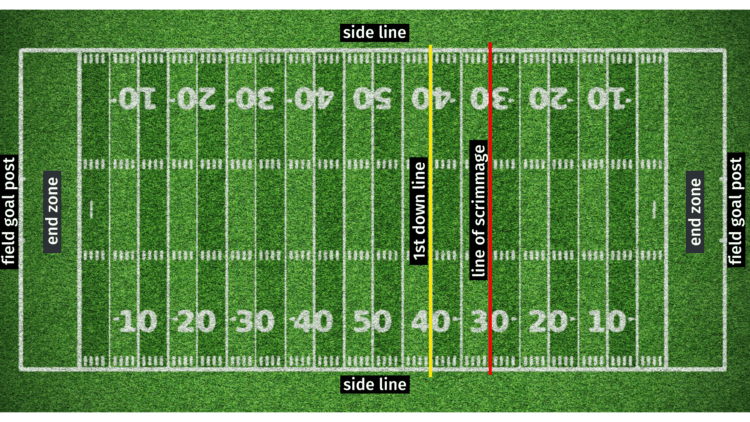
OBJECTIVE OF AMERICAN FOOTBALL: Score more points than the opposing team by moving the ball across the field and scoring touchdowns.
NUMBER OF PLAYERS: Around 45 players on each team, 11 players on the field at a given time
MATERIALS: 1 football, padding, helmets
TYPE OF GAME: Sport
AUDIENCE: 10+
OVERVIEW OF AMERICAN FOOTBALL
American football is the most popular sport in the USA. It is an exciting contact sport that is so strategic that it is often compared to chess! An overwhelming 112 million people tuned in to watch the Superbowl in 2022, but we still aren’t quite sure how many were just watching for the halftime show.
SETUP

FIELD
An American football field is 100 yards long with two end zones that are 10 yards each. The field is 53 yards wide, with side lines marking the out-of-bounds zone. An NFL field is divided into yard lines with the 50-yard line in the center. The yard lines count down towards the end zone. The yard line closest to the end zone on each side of the field is the 10-yard line.
Behind each end zone is a field goal post. The field goal post is 30 feet tall with an initial base of 10 feet high and two 20-foot high poles on each side which are 18 feet and 6 inches apart.
POSITIONS
There are always 22 players on the field, 11 on each team. An American football team is generally divided into defensive, offensive, and special teams. At the professional level, players will very rarely play on multiple teams.
OFFENSE
- QUARTERBACK: The most important offensive player. The quarterback will almost always start each play with the ball in their hand and lead the offense. Then, they will throw the ball to the wide receivers or hand it off to the running backs.
- OFFENSIVE LINEMEN: These five players guard the quarterback and prevent defensive players from breaching the line and tackling the quarterback.
- WIDE RECEIVERS: Wide receivers run down the field and catch passes from the quarterback. Their primary role is to score touchdowns.
- RUNNING BACKS: The running backs stand behind the quarterback and will either be used for trick plays to “fake out” the defensive or be handed the ball and run down the field.
- TIGHT END: Tight ends are hybrid players that can either block with the offensive line or run downfield to catch passes. They are usually strong athletes that can also run fast.
DEFENSE
- DEFENSIVE LINEMEN: The defensive linemen stand directly across from the offensive line. There are usually 3 or 4 of them, and their main goal is to break the offensive line and tackle the quarterback before he can hand off or pass the ball.
- LINEBACKERS: There are generally 3-4 linebackers on a defensive football team. Linebackers stand directly behind the defensive line. They are responsible for calling out defensive plays, rushing the quarterback, and tackling the running backs.
- CORNERBACKS: Cornerbacks are the fastest defensive players on a team. Two cornerbacks will line up directly across from the wide receivers. They guard the wide receivers and prevent them from catching passes.
- SAFETIES: There are two safeties on a football team. The strong safety is, in essence, a faster linebacker that can hold back and prevent receivers from catching the ball. The free safety is a fast player that reacts to the current play by tackling receivers and running backs or blocking far passes.
SPECIAL TEAMS
In American football, there are also special teams on the field during kickoffs, punts, and field goals. Each team will have a special team for kicking and receiving. The kicker will be responsible for kicking field goals and kicking the ball to the other side of the field during each quarter or after the team scores a touchdown. The punter is responsible for punting the ball to the other team when the offensive team fails to make a first down. The other players on the special team will be responsible for either blocking, receiving the ball, or tackling the player that receives the ball.
GAMEPLAY

American football consists of four 15-minute quarters, but the clock is stopped after each play and restarted once the ball is snapped to the quarterback. There is a 15-minute break in between the 2nd and 3rd quarters. There is also a short break during the changeover from offense to defense.
The game begins with a coin toss to determine which team gets to kick off first.
KICK-OFF
The team that wins the coin toss receives the ball first. In the second half of the game (3rd quarter), the other team will receive the ball first. The kick-off team stands in a straight line across the width of the field with the kicker in the middle. After the kicker has kicked the ball down the field, the kick-off team runs to stop the receiving team. A kick from a kick-off must go at least 10 yards.
Kickoffs also occur after each touchdown or field goal. The team that scored will kick off to the other team.
DOWNS
The offensive team has four tries (or downs) to either score a touchdown, kick a field goal, or move the ball 10 yards. If the team moves the ball 10 yards downfield from the line of scrimmage (the point at which the ball was during the last play), they are awarded a first down.
A first down means the team has four more tries to score a point or make another first down.
The defensive team will try to prevent the offensive team from moving the ball downfield by sacking the quarterback, blocking passes, or tackling the running backs. If the defensive team stops the offense from scoring or making a first down on all four downs, the possession of the ball is handed over to the defensive team.
When the ball is handed over to the other team after a fourth down, the opposing team starts on the same line of scrimmage but faces the opposite direction.
PUNTING
The offensive team also has the opportunity to punt the ball if they are on a fourth down and do not want to risk handing over the ball to the opposing team. Punting is when the offensive team kicks the ball downfield from their current position, essentially handing the ball over the ball to the other team instead of attempting to score.
SCORING
There are two main ways to score in American football: touchdowns and field goals.
TOUCHDOWN
A touchdown is when an offensive team player catches or runs the ball into the end zone. A touchdown is worth 6 points.
EXTRA POINTS
After scoring a touchdown, the offensive team has a chance to score extra points. They can kick the ball through the field goalpost from 33 yards away for one extra point or score a two-point conversion by running or passing the ball into the end zone from the two-yard line.
FIELD GOALS
If the offensive team cannot score a touchdown, they can attempt to kick a field goal for three points. There is no specific rule for how far a team can be from the field goal post to attempt a field goal, but most teams will not attempt a field goal over 55 yards.
PENALTIES/FOULS
While American football is a contact sport, there are still some rules for how players must conduct themselves on the field and what they can and cannot do. If a player breaks the rules, there will be a penalty. If the offense commits a foul, the referee will give the offense a 5-15 yard penalty in which the line of scrimmage will be moved backward. If the defense commits a foul, the offense will be awarded a first down and be allowed to move forward 5-15 yards.
Here are some examples of fouls in American football
- Holding
- 12 men on the field
- Offsides (crossing the line of scrimmage before the start of the play)
- Illegal pass or handoff
- Pass interference
- Illegal contact
- Fair catch interference
END OF GAME
The winner of a football game is the team with the highest score at the end of the fourth quarter. If the game is tied at the end of the fourth quarter, a 10-minute overtime period starts. If the game is still tied after this period, the game will officially end in a tie.
- 20+ FREE PRINTABLE BABY SHOWER GAMES - April 16, 2024
- 20+ College Party Games for the Best Night Ever! - April 2, 2024
- 31 BEST MOVIE DRINKING GAMES - March 14, 2024